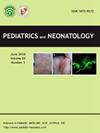Cerebral tissue oxygen desaturations and increased fractional oxygen extraction events vary by gestational age in preterm infants
IF 2.3
4区 医学
Q2 PEDIATRICS
引用次数: 0
Abstract
Background and objectives
Cerebral tissue oxygen saturation (SctO2) and cerebral fractional tissue oxygen extraction (cFTOE) changes with GA in preterm infants. This study examines changes in frequency, duration, and severity of SctO2 desaturation and increased cFTOE with GA.
Study design
The lower limit of normal SctO2, the event threshold, was calculated using a tolerance interval method with 95% confidence interval (CI) and 90% probability. Cerebral desaturation events were defined as: 1) a drop below event threshold for at least 30 s (s), 2) preceded by a period above the event threshold for at least 30s, and 3) followed by a period above the threshold for at least 60s.
Results
86% of infants <28 wk experienced one or more SctO2 desaturation event compared to 57% in >28 wk, odds ratios (OR) 4.5 (CI:1.3–15.3, p = 0.016). The severity of SctO2 desaturation events decreases at a rate of 77.9 units per wk increase in GA (p < 0.001). 39.3% of infants <28 wk experienced one or more increased cFTOE events compared to 28.6% in >28 wk, OR 1.6 (CI:0.6–4.4, p = 0.35). The severity of increasing cFTOE events decreased by 69.7 units per wk increase in GA (p < 0.001).
Conclusion
Cerebral tissue oxygen desaturation events decrease in frequency and severity with increasing GA. The severity of increased cFTOE episodes decrease with GA.
早产儿脑组织氧去饱和度和氧萃取分数增加事件因胎龄而异。
本文章由计算机程序翻译,如有差异,请以英文原文为准。
求助全文
约1分钟内获得全文
求助全文
来源期刊

Pediatrics and Neonatology
PEDIATRICS-
CiteScore
3.10
自引率
0.00%
发文量
170
审稿时长
48 days
期刊介绍:
Pediatrics and Neonatology is the official peer-reviewed publication of the Taiwan Pediatric Association and The Society of Neonatology ROC, and is indexed in EMBASE and SCOPUS. Articles on clinical and laboratory research in pediatrics and related fields are eligible for consideration.
 求助内容:
求助内容: 应助结果提醒方式:
应助结果提醒方式:


